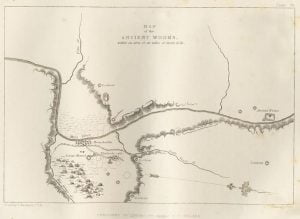
Grave Creek mound – A noted prehistoric Indian mound, situated near Moundsville, Marshall County, West Virginia, at the point where Grave Creek unites with Ohio River. It was visited as early as 1734, as appears from this date cut on a tree growing from its summit, but was first described by Hart in 1797 1 , since which time it has been repeatedly described and figured, attention of scholars having been called to it chiefly by an inscription on a small stone which was reputed to have been found in the mound during its excavation. The mound is conical inform, being probably the largest example of this type in the United States, having a diameter at the base of about 320 ft, a height of 70 ft, and 1,870,000 cu. ft of solid contents. It is symmetrical in form and has a dish-shaped depression in the top. It was excavated in 1838 by the proprietor, who first carried a horizontal drift at the base to the center and a shaft from the top to connect with the drift. Two burial vaults were discovered, one at the base and an other 30 ft above, each constructed of logs and covered with stones, which had sunk as the wood decayed, leaving the depression in the summit. Squier and Davis 2 assert that under the center of the mound there was a slight natural elevation into which the lower vault had been sunk. This vault contained two human skeletons, the upper vault but one. Accompanying the skeletons were 3,000 to 4,000 shell beads, ornaments of mica, several copper bracelets, and various articles of stone, including the inscribed stone mentioned, the inscription on which has received various interpretations. An illustration of this inscription was first published in the Cincinnati Chronicle, Feb. 2, 1839; another in the American Pioneer, II, no. 5, 1843. Rafn, whose tendency was to give a foreign interpretation to Indian inscriptions, inclined to the opinion that the inscribed characters were Anglo-Saxon runes, while Schoolcraft concluded that they belonged to some 8 or 9 different alphabets, as old Greek, Etruscan, etc. A committee of the Ohio Archaeological and Historical Society in 1877 reached the following conclusions:
- The inscription is not necessarily to be regarded as alphabetical.
- If it is assumed to be alphabetical, it can not be referred to any known language.
- It is precisely of such a character as would be the result of an ordinary attempt to manufacture an inscription.
- Its manufacture is within the capacity of any laborer of ordinary intelligence who may have been employed in the work of exploring the mound.
- At the time of its discovery there was no proper scrutiny of the inscription to determine whether it was of recent manufacture or not.
- The evidence that it came from the mound is by no means conclusive.
- Its history is such that the subsequent discovery of unquestioned ancient inscriptions with similar characters would warrant us in concluding that this also is ancient.
- Until its authenticity is thus fully established, it ought not to be regarded as any evidence of the character, ethnical relationship, or intellectual culture of the builders of the mounds.
Whittlesey, in 1872, expressed the belief that the inscription was a forgery.
Read further about the Grave Creek Mound Archaeological Complex
Consult:
- Clemens in Morton, Crania Americana, 221, 1839;
- Schoolcraft in Trans. Am. Ethnol. Soc., i, 369-420, 1846;
- Squier and Davis, Anc. Monuments, 168-170, 1848;
- Thomas in 5th Rep. B. A. E., 51, 1887;
- Thomas in Cat. Prehistoric Works, 222, 1891, with bibliographic references;
- Whittlesey in Tracts West. Res. Hist. Soc., i, nos. 9 and 33, 1877, and ii, no. 44, 1888. (C. T.)
Citations:

